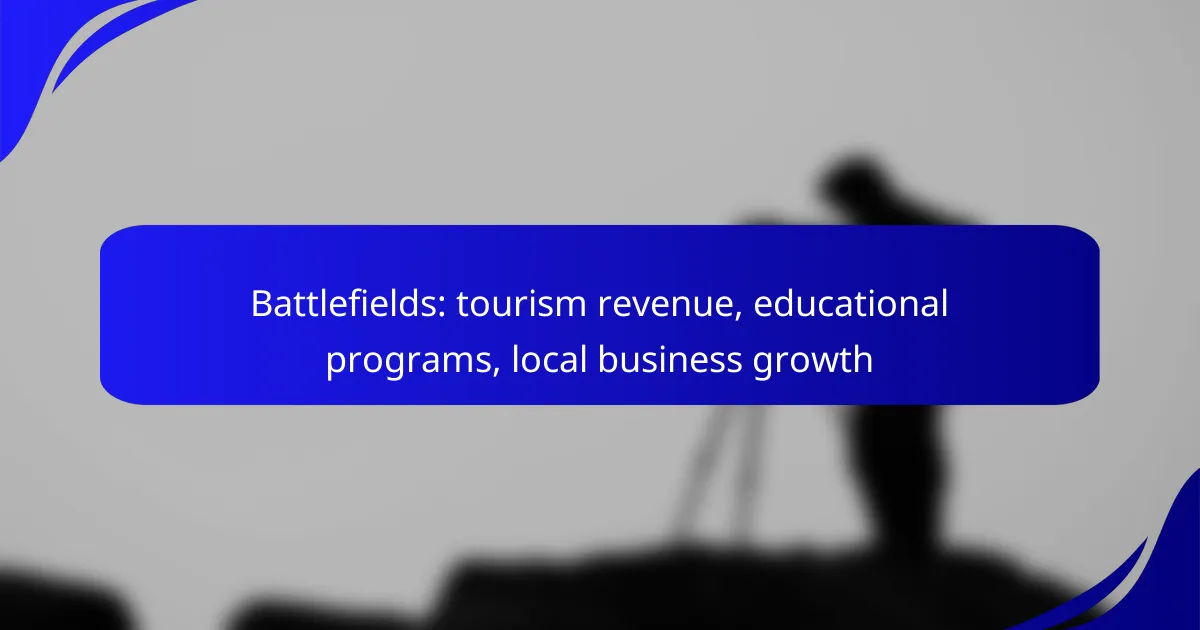Battlefields in Australia serve as vital hubs for tourism, drawing history enthusiasts and contributing significantly to local economies. By offering educational programs and immersive experiences, these sites not only enhance public understanding of military history but also foster growth for local businesses through increased visitor spending.

How do battlefields contribute to tourism revenue in Australia?
Battlefields in Australia significantly contribute to tourism revenue by attracting visitors interested in history and heritage. These sites not only educate the public about historical events but also stimulate local economies through increased visitor spending.
Historical significance attracts visitors
The historical importance of battlefields draws both domestic and international tourists. Sites like Gallipoli and the Australian War Memorial serve as poignant reminders of the country’s military history, appealing to those interested in learning about Australia’s role in various conflicts.
Many visitors seek immersive experiences, such as guided tours and reenactments, which enhance their understanding of the events that took place. This educational aspect often leads to longer stays and increased spending in local accommodations and restaurants.
Local events boost economic activity
Local events centered around battlefields, such as commemorative ceremonies and historical festivals, significantly boost economic activity. These gatherings attract large crowds, providing opportunities for local businesses to thrive through increased sales in food, merchandise, and services.
Moreover, such events often encourage collaboration among local vendors, creating a vibrant marketplace that enhances the overall visitor experience. This synergy can lead to repeat visits and positive word-of-mouth promotion.
Partnerships with travel agencies enhance visibility
Collaborations between battlefield sites and travel agencies play a crucial role in enhancing visibility and attracting tourists. By offering packaged tours that include battlefield visits, agencies can provide a comprehensive experience that appeals to history enthusiasts.
These partnerships can also leverage online marketing strategies, reaching broader audiences through social media and travel blogs. Effective promotion can lead to increased bookings and greater awareness of the historical significance of these sites.
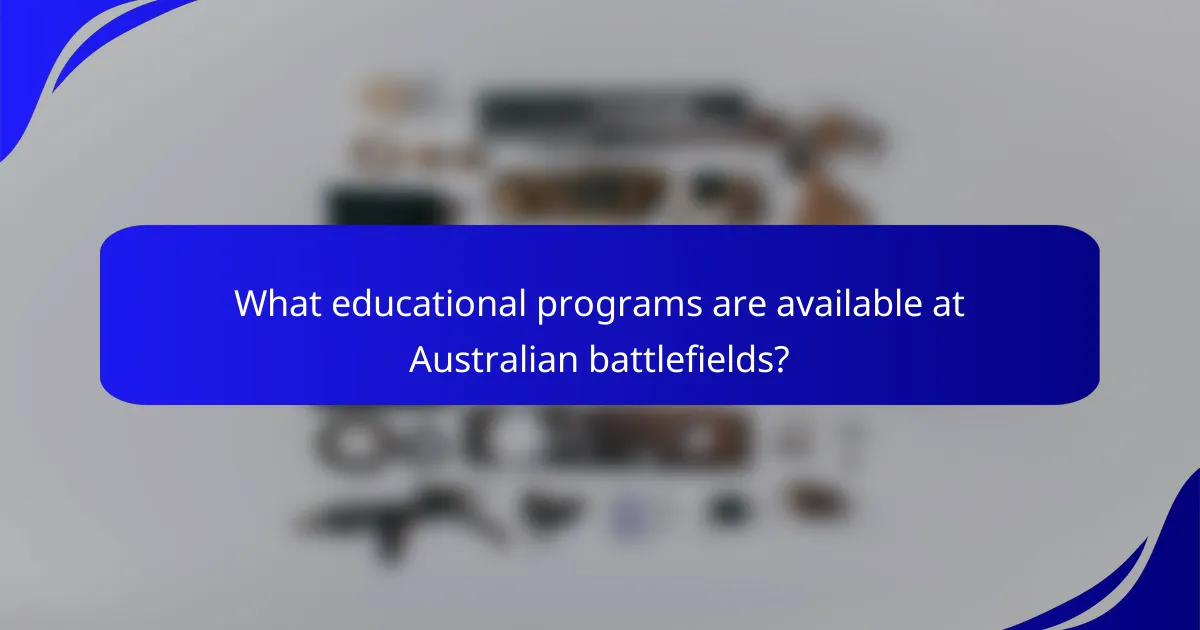
What educational programs are available at Australian battlefields?
Australian battlefields offer a variety of educational programs aimed at enhancing understanding of military history and its significance. These programs cater to schools, universities, and the general public, providing immersive learning experiences through guided tours, workshops, and academic collaborations.
Guided tours for schools
Guided tours for schools are designed to engage students with the history of Australian battlefields. These tours typically include expert-led discussions on key events, figures, and the broader context of Australia’s military involvement. Schools can arrange tailored tours that align with their curriculum, ensuring relevance and educational value.
Many battlefield sites offer special rates for school groups, making these tours accessible. Teachers often find that these experiences enhance students’ understanding of history and foster a deeper appreciation for the sacrifices made during conflicts.
Workshops on military history
Workshops on military history provide hands-on learning opportunities for participants of all ages. These workshops often cover topics such as battlefield tactics, the experiences of soldiers, and the impact of wars on Australian society. They may include interactive elements like role-playing or artifact handling to deepen engagement.
Typically, workshops are conducted by historians or military experts, ensuring accurate and insightful content. Schools and community groups can book these sessions, which can last from a few hours to a full day, depending on the depth of the topic.
Collaborations with universities
Collaborations with universities enhance the educational offerings at Australian battlefields by integrating academic research with public education. Many universities partner with battlefield sites to develop programs that explore historical narratives, preservation techniques, and the social implications of war.
These collaborations often result in public lectures, research projects, and student internships, providing a richer educational experience. Universities may also offer credit for participation in these programs, encouraging students to engage with history in a meaningful way.
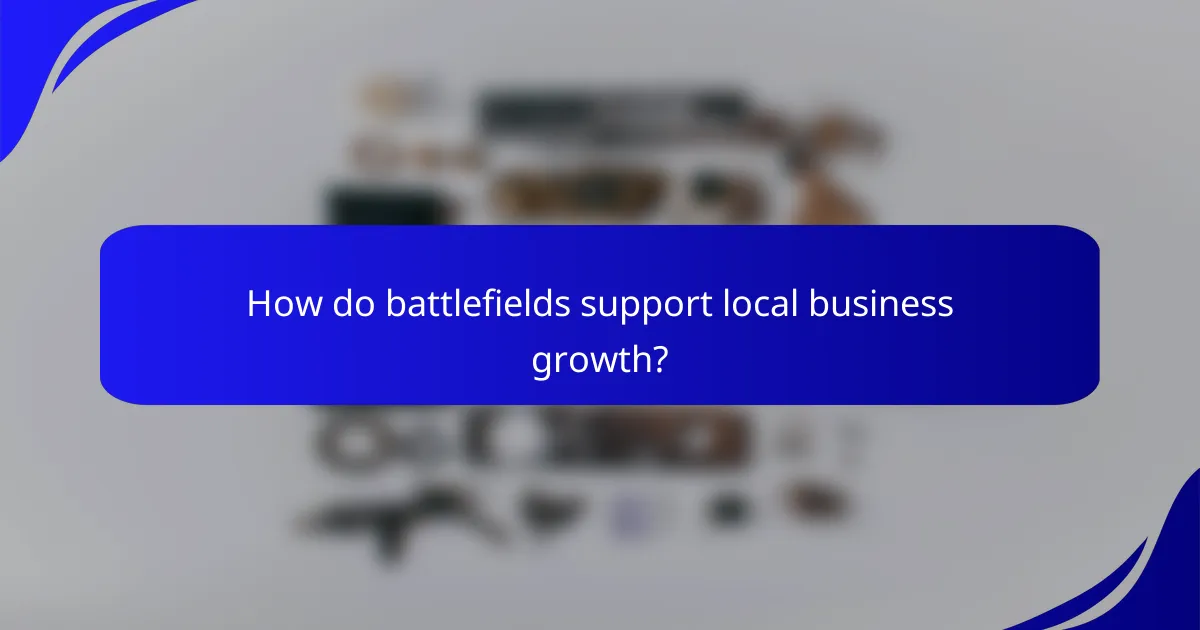
How do battlefields support local business growth?
Battlefields significantly boost local business growth by attracting tourists interested in history and education. This influx of visitors creates opportunities for shops, restaurants, and artisans to thrive, directly benefiting the local economy.
Increased foot traffic for local shops
Battlefields draw large numbers of visitors, leading to increased foot traffic for nearby shops. Local retailers can capitalize on this by offering products that appeal to tourists, such as historical books, souvenirs, and apparel. Shops that align their inventory with the interests of battlefield visitors often see a marked increase in sales.
Additionally, promotional events and partnerships with battlefield organizations can further enhance visibility, encouraging tourists to explore local offerings. Seasonal sales and themed merchandise can also attract more customers during peak tourist seasons.
Restaurants benefiting from tourism
Restaurants located near battlefields frequently experience a surge in business due to the influx of tourists. Many visitors seek dining options after exploring the sites, providing a steady stream of customers throughout the day. Establishments that offer local cuisine or themed dining experiences can particularly attract history enthusiasts.
To maximize this opportunity, restaurants can create special menus or discounts for battlefield visitors, enhancing their appeal. Collaborating with local tourism boards to promote dining options can also help restaurants capture more of the tourist market.
Local artisans selling memorabilia
Local artisans benefit from battlefield tourism by selling unique memorabilia that resonates with visitors. Items such as handcrafted jewelry, artwork, and historical replicas can attract tourists looking for authentic souvenirs. Artisans can set up booths at local markets or partner with shops to reach a broader audience.
Participating in battlefield events or festivals can further enhance visibility for local artisans. Offering workshops or demonstrations can engage tourists and create a memorable experience, encouraging them to purchase items as keepsakes of their visit.
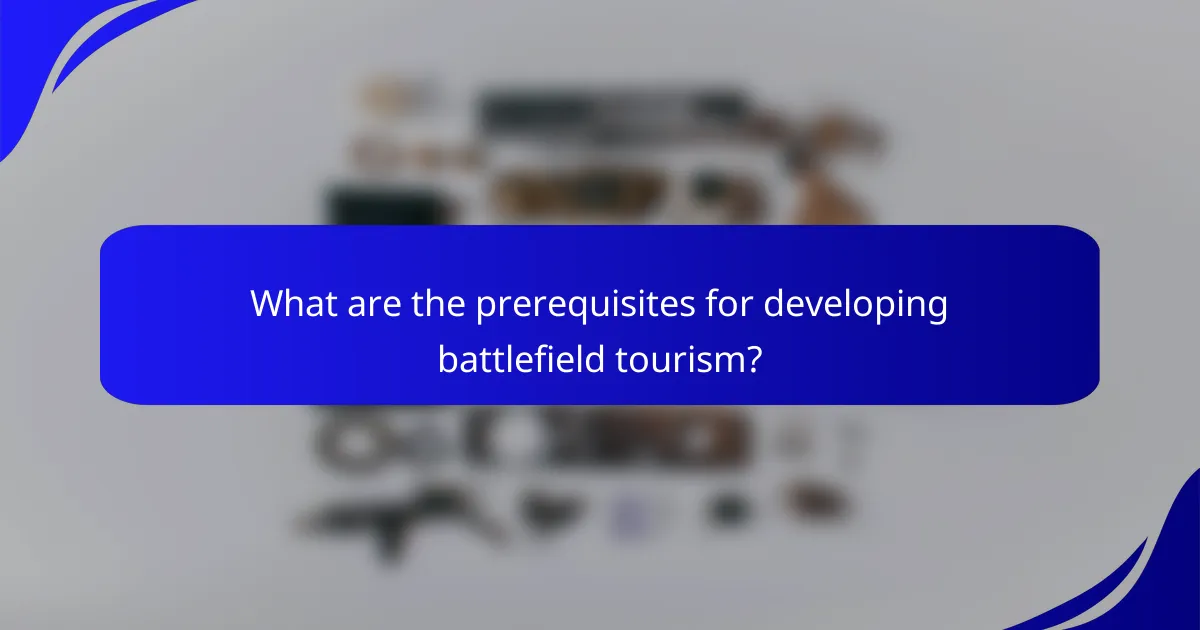
What are the prerequisites for developing battlefield tourism?
Developing battlefield tourism requires a combination of historical preservation, community engagement, and effective marketing strategies. These elements ensure that the historical significance of the site is maintained while also benefiting the local economy.
Historical preservation requirements
Historical preservation is crucial for battlefield tourism, as it safeguards the integrity of the site. This often involves adhering to national and local regulations regarding the conservation of historical landmarks, which can include maintaining original structures and artifacts.
Potential developers should consider forming partnerships with historical societies or government agencies to secure funding and expertise. Engaging in regular assessments can help identify necessary restorations and ensure compliance with preservation standards.
Community engagement initiatives
Community engagement is essential for the success of battlefield tourism, as it fosters local support and involvement. Initiatives can include organizing educational programs, workshops, and events that highlight the historical significance of the battlefield, encouraging local residents to participate actively.
Building relationships with local businesses can also enhance community engagement. Collaborating with restaurants, hotels, and shops to create packages or promotions can attract tourists while supporting the local economy. Regular feedback from the community can help refine these initiatives and ensure they meet local interests and needs.
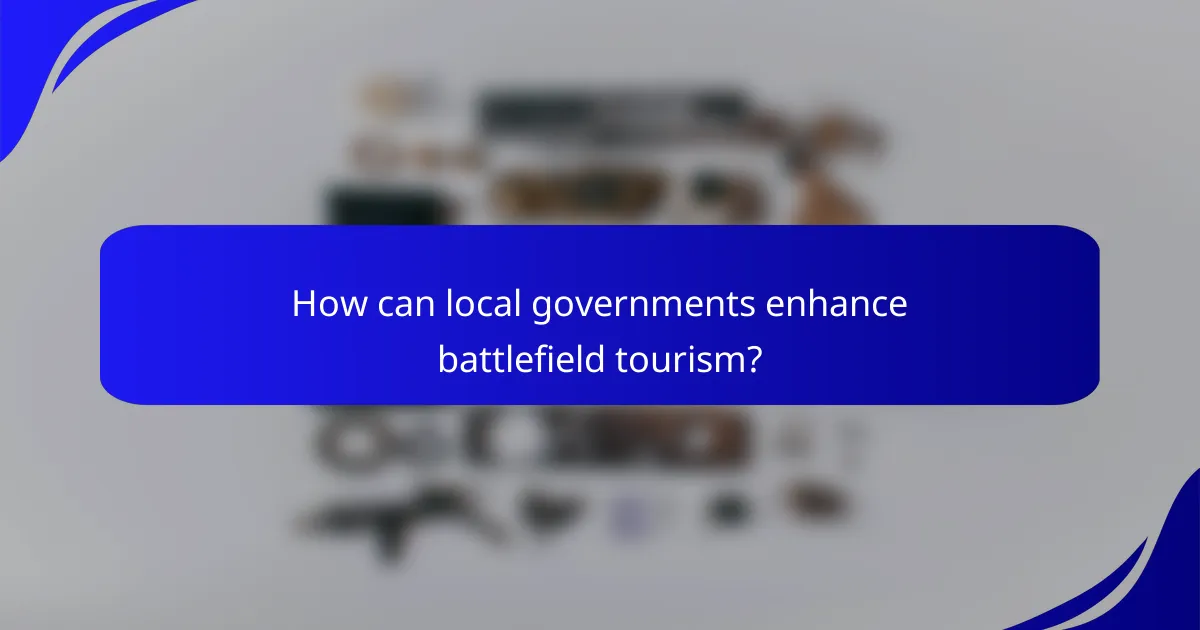
How can local governments enhance battlefield tourism?
Local governments can enhance battlefield tourism by investing in infrastructure and implementing targeted marketing campaigns. These strategies not only improve visitor experiences but also boost local economies through increased tourism revenue.
Investment in infrastructure
Investing in infrastructure is crucial for attracting and accommodating tourists at battlefield sites. This includes improving access roads, creating visitor centers, and ensuring adequate signage that provides historical context and directions. Well-maintained facilities can significantly enhance the overall visitor experience.
Local governments should consider partnerships with private entities to fund these improvements. Grants and public funding can also be utilized to cover costs, ensuring that the infrastructure meets the needs of both tourists and the local community.
Marketing campaigns targeting tourists
Effective marketing campaigns are essential for raising awareness about battlefield tourism. Local governments should leverage social media, travel websites, and partnerships with travel agencies to promote historical sites. Highlighting unique features, events, and educational programs can attract a broader audience.
Additionally, collaborating with local businesses to create package deals can enhance the appeal of battlefield tourism. Offering discounts for combined visits to local attractions or accommodations can incentivize tourists to extend their stay and explore the area further.

What are the emerging trends in battlefield tourism?
Emerging trends in battlefield tourism focus on enhancing visitor engagement through technology, storytelling, and sustainability. These trends aim to create a more enriching experience while supporting local economies and preserving historical sites.
Virtual reality experiences
Virtual reality (VR) experiences are revolutionizing battlefield tourism by allowing visitors to immerse themselves in historical events. Through VR technology, tourists can experience pivotal moments from the past, making history more tangible and engaging.
Many battlefield sites are now incorporating VR into their tours, providing interactive experiences that can enhance understanding and emotional connection. For instance, a visitor might don a headset to witness a reenactment of a famous battle, gaining insights into the strategies and human experiences involved.
Focus on immersive storytelling
Immersive storytelling is becoming a key component of battlefield tourism, as sites strive to convey the narratives behind the events. This approach combines guided tours, multimedia presentations, and personal stories to create a compelling narrative that resonates with visitors.
By focusing on the human aspects of battles, such as personal accounts from soldiers and civilians, sites can foster a deeper emotional connection. This method not only educates but also encourages reflection on the impact of war on society.
Sustainable tourism practices
Sustainable tourism practices are increasingly important in battlefield tourism, as sites seek to balance visitor engagement with environmental and cultural preservation. This includes minimizing the ecological footprint of tourism activities and ensuring that local communities benefit from tourism revenue.
Examples of sustainable practices include promoting eco-friendly transportation options, implementing waste reduction strategies, and supporting local businesses through partnerships. Tourists are encouraged to participate in responsible tourism, such as respecting historical sites and engaging with local cultures in a meaningful way.
